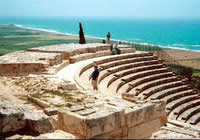|
|
| |
| |
| |
|
| |
 |
| |
|
| uses Google technology and indexes
only and selectively internet - libraries
having books with free public access |
|
 |
|
|
 |
|
| |
|
| |
Previous | |
Next |
|
 |
CLAUDE DELAVAL COBHAM
Exerpta Cypria
page 117 View PDF version of this page l'Alt UTA.
ίου
might be better understood, to despatch to Venice Mesner Niccolo Donato, who hud been sent on a niissTou to the island, and was «tili with his two galleys in the harlxjur of FainRgosta; with whom there reached Venice Monsignor Girolamo Kagazzoni, Bishop of the city, a man fully acquainted with the position, and admirably adapted for this duty.
The city of Famagosta is situated at the East end of the Island uf Cyprus on a luw shore close tu the sea, whence it had its Greek name Amathus which menus kühlen hi the sand. It stands almost in the centre of a semicircle formed by two promontories, Carpasio aud IVdaglio, called by men uf oui* day the one Cape Sant' Andren, the other Cape della Grecia. The former runs ont for a distance of over ninety miles, and breaking the circle, makes an end to the island towards the north in α very sharp point. This tract was of old called Salamini» from the ancient city of Salamina, built by Teucer after the fall of Troy, nnd afterwards Costanza. Some traces of this remain, and, perhaps to murk the fonner glory of their city, they are still called by the natives "Old Famagosta." The city has a harlxmr, lying between east and north, funned by certain shoals and rocks, broken here and there by narrow channels, which catch the first force of the waves, and guarii from storms the little bay which lies between thein and the shore; but the depth of this is but small, so that few vessels of any size can anchor in it. The entrance faces north, and is closed with α chain attached to a spur of rock which juts out some forty paces from the fortress; while a small castle, with four towers of antique style, commands the bari JOUI*. The lines of the fortifications form an imperfect square, for they run freni the seashore from west tu north in zigzags, and enclose a gradually widening space, so that the sides are to some extent unequal : two of thein face the sea, and two the land : in one of the latter was η small hexagonal towr called Diainantino, in which was the so-called Liurisso gate, lu the other is a bastion of great size built a few years before the siege, with double Hanks, a broad freut and orillons, arranged fur a modern battery. The circnit uf the fortress was rather inure than two Italian miles, the whole enclosed by an excellent wall of squared stone {tufo or htfa). On the land side it was twenty feet thick, with a platform of twelve paces, above which rese a parapet uver four feet in height: the ditch on every side was fifteen or at least twelve paces bread, chiefly cut ont of the rock, bnt where this broke uff, a counterscarp was built of stone. Set about the walls were many towers, but most of them BO small that they allowed room for small pieces of artillery only: a few of larger capacity between the Lini isso gate and the Arsenal, called from their shape demi-lunes, were in many respects equally defective, but were considered stronger aud mure useful because they were vaulted, and allowed means uf exit on either side. The cunntry round the fortress is all perfectly fiat, only on the northwest and north a few villages are built υη ground which lises into something like low hills, little more than a mile from the city. There was an impression that the enemy woidd encamp in this direction, both because the fort was weaker on that side, and also because there were caves, whence the peuple of Famagosta used to dig stone for their buildings, within which a large number of men might be safely and conveniently lodged. Bnt the Tnrks were aware that, according tu their fashion of camping, the ground would not suit them, because of the rocks which lay all about, and spread out their whole force along the shore on the other side, where it stretches for three miles from the city to the sea. This part had been full of beautiful gardens of oranges, lemons and many other kinds of fraitbearing trees, but must of them had been already cut down by the inhabitants themselves, to leave nothing which might be of profit to the enemy: the Turks however had the use of the many wells which stored fur the gardens abundance of exquisitely clear and cold water, most refreshing to troops relaxed and overcome by the intense heat of the country.
View PDF version of this page
|
 |
| |
Previous |
First |
Next |
|
|
|